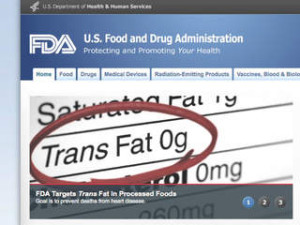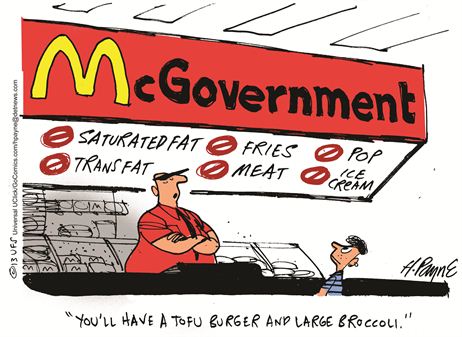FDA moves to ban trans fats from processed foods
Daily News Article — Posted on November 12, 2013
 (from London’s Daily Telegraph) AP – The FDA has moved towards banning trans fat from processed foods like microwave popcorn and frozen pizzas, saying the artery-clogging oils are not safe for humans to eat.
(from London’s Daily Telegraph) AP – The FDA has moved towards banning trans fat from processed foods like microwave popcorn and frozen pizzas, saying the artery-clogging oils are not safe for humans to eat.
Margaret Hamburg, the commissioner of the US Food and Drug Administration (FDA) said that the move could prevent 20,000 heart attacks and 7,000 deaths each year.
The agency, which monitors food and drug safety, is not yet setting a timeline for the phase-out, but it will collect comments for two months before officials determine how long it will take. Different foods may have different timelines, depending how easy it is to find a substitute.
Though they have been removed from many items, the trans fats are still found in processed foods, including in some microwave popcorns and frozen pizzas, refrigerated doughs, cookies, biscuits and ready-to-use frostings. They are also sometimes used by restaurants that use the fats for frying. Many larger chains have phased them out, but smaller restaurants may still get food containing trans fats from suppliers.

Trans fats are widely considered the worst kind for your heart, even worse than saturated fats, which also can contribute to heart disease. Trans fats are used both in processed food and in restaurants, often to improve the texture, shelf life or flavor of foods.
To phase them out, the FDA said it had made a preliminary determination that trans fats no longer fall in the agency’s “generally recognized as safe” category, which is reserved for thousands of additives that manufacturers can add to foods without FDA review. Once trans fats are off the list, anyone who wants to use them would have to petition the agency for a regulation allowing it, and that would likely not be approved.
The FDA is not targeting small amounts of trans fats that occur naturally in some meat and dairy products, because they would be too difficult to remove and are not considered a major public health threat on their own.
Scientists say there are no health benefits to trans fats and say they can raise levels of so-called “bad” cholesterol, increasing the risk of heart disease – the leading cause of death in the United States.

Cartoon by Henry Payne
Michael Bloomberg, the outgoing mayor of New York, who banned trans fats from the city in 2008, said that the FDA plan “deserves great credit.” “The groundbreaking public health policies we have adopted here in New York City have become a model for the nation for one reason: they’ve worked,” he said.
But Dr. Joe Schwarcz, who specializes in debunking heath myths, said it has earned an unfair stigma.
“Trans fats are made out to be a great villain – but they are probably perceived as worse than they are,” Schwarcz told The Post.
He said people should be more concerned with their overall diet.
“If you eat a bag of potato chips with trans fat, it’s not going to kill you, it’s not arsenic. It’s your overall intake you need to look at,” he said, adding trans fat in moderation is fine.
Products such as Oreos and Top Ramen have already reduced trans fats to zero grams per serving. But eliminating trans fats changes the flavor of the food, can drive up manufacturing costs and make the snack’s shelf-life shorter.
A representative for the FDA said the agency’s top concern is safety.
“One of the FDA’s core regulatory functions is ensuring that food, including all substances added to food, is safe,” said Michael Taylor, and FDA commissioner, said in a statement.
Reprinted here for educational purposes only. From a Telegraph news report by the Associated Press, with excerpts added from a New York Post article. May not be reproduced on other websites without permission from the Daily Telegraph.
Background
The Food and Drug Administration on Thursday ruled for the first time that trans fats aren’t generally considered safe in foods, a sharp shift in policy that could lead to banning trans fats in baked goods, refrigerated dough products, frosting and other foods. Here is a rundown explaining trans fats and where they are currently found: (from wsj.com)
What are trans fats, and why are they bad?
Trans fats, or trans fatty acids (the name comes from their chemical structure), are an ingredient in some foods that has been shown to increase levels of low-density lipoprotein, or LDL, known as “bad cholesterol.” This blocks arteries and can lead to heart disease, the No. 1 killer in the U.S.
Where do trans fats come from?
Some of it is produced naturally in the stomach of grazing animals, and therefore present in small amounts in milk products and meat. But the main source is from vegetable oil that has been processed with hydrogen to make it more solid. Food makers use these artificial trans fats, known as partially hydrogenated oils, to improve texture and make products last longer.
Where are they found?
Trans fat has been used in many food products, particularly cookies, muffins, cakes, and other baked goods, as well as frostings. According to the FDA, it also is used in some snack foods (such as microwave popcorn), frozen pizza, vegetable shortenings, and coffee creamer.
What’s been done about them before the ban announced Thursday?
Trans fat became popular in part because of health concerns – vegetable oils were considered healthier than the saturated animal fats that were widely used. In the 1980s and 90s, researchers began linking trans fats to heart disease. In 2006, after much debate, the FDA began requiring food companies to put labels on foods containing trans fat. Before that, only consumers familiar with ingredients jargon like “partially hydrogenated vegetable oil” and “vegetable shortening” would have known that their foods contained trans fat. Some states and localities have also adopted regulations limiting the use of trans fat.
Where have trans fats been pulled from?
The FDA’s labeling requirement, and growing public concerns about the health risks of trans fat, prompted many big chains and food companies to stop using the stuff, or cut way back. Mondelez International, then part of Kraft, replaced it with non-hyrdogenated vegetable oil in its Oreo cookies in 2006. On its website, Mondelez says it has completed a multi-year effort “to eliminate or significantly reduce trans fats from our entire portfolio around the globe.” Fast food and other restaurants were once a big user of trans fat, but McDonald’s, Burger King, Starbucks and KFC all dropped trans fats (Burger King and KFC still have small amounts in some menu items; a Burger King spokesman says some of its meat and dairy items have the naturally occurring trans fat). And Long John Silver’s has announced plans to switch all U.S. restaurants to trans-fat-free cooking oil. Church’s Chicken also expects to have all stores converted to trans-fat-free oils by Christmas.
What foods still contain trans fat?
Sara Lee cheesecakes, Betty Crocker cake mix, and Pop Secret popcorn all list partially hydrogenated oils in their ingredients. The Center for Science in the Public Interest, which has been a leading crusader against trans fat, identifies some fast-food chains, including Popeye’s Louisiana Kitchen, that still use trans fats in some products.
Why are they still in foods?
Hydrogenated oils are easy to use. They can withstand repeated heating without breaking down, and the process can turn liquid oil into solid, making for easier transportation and wider uses, according to Harvard School of Public Health’s Nutrition Source website. Hydrogenation also is relatively cheap - which explains why it continues to be widely used in many emerging and developing economies.
The Food and Drug Administration (FDA or USFDA) is an agency of the U.S. Department of Health and Human Services, one of the U.S. federal executive departments.
- The FDA is responsible for protecting and promoting public health through the regulation and supervision of food safety, tobacco products, dietary supplements, prescription and over-the-counter pharmaceutical drugs (medications), vaccines, biopharmaceuticals, blood transfusions, medical devices, electromagnetic radiation emitting devices (ERED), veterinary products, and cosmetics.
- The FDA also enforces other laws, notably Section 361 of the Public Health Service Act and associated regulations, many of which are not directly related to food or drugs. These include sanitation requirements on interstate travel and control of disease on products ranging from certain household pets [etc.].
- The FDA is led by the Commissioner of Food and Drugs, appointed by the President with the advice and consent of the Senate. The Commissioner reports to the Secretary of Health and Human Services. The 21st and current Commissioner is Dr. Margaret A. Hamburg. She has served as Commissioner since February 2009.
- The FDA has its headquarters in Maryland, and also has 223 field offices and 13 laboratories located throughout the 50 states, the United States Virgin Islands, and Puerto Rico. In 2008, the FDA started opening offices in foreign countries, including China, India, Costa Rica, Chile, Belgium, and the United Kingdom.
- The FDA’s federal budget for fiscal year – FY 2012 totaled $4.36 billion (the proposed 2014 budget is $4.7 billion). About $2 billion of this budget is generated by user fees. Pharmaceutical firms pay the majority of these fees, which are used to expedite drug reviews.
- The FDA’s federal budget request for fiscal year (FY) 2008 totaled $2.1 billion, a $105.8 million increase from what it received for fiscal year 2007. (from wikipedia)
